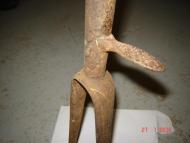Eugeune Meyer from Paris (France) started building boneshakers in 1869 and he is credited as having invented the bicycle wheel with thin metal spokes - one of the most important improvements of the bicycle ever.
Meyer built bicycles during the 1870's and continued until (at least) 1884.
Most Meyer bicycles have clear makers plates, but they do not bear serial numbers.
The makers plate could tell us something about the age of the bicycle:
First address: Meyer et Cie, 35 Avenue de Wagram
Second address: E.Meyer, 7 Rue des Acacias Ternes
Third address: E.Meyer, 33 Avenue Rapp
Meyer also was one of the first to use hollow backbones (starting 1872!) but he also kept using solid backbones until 1881 - there are no catalogues known so dating these bicycles is an awkward job.
From 1882 onwards, they also built bicycles with oval hollow backbone.
On the website of Robert Sterba are two Meyer bicycles:
The 'grand-bi' you see in these pictures has a lot of unique features, making it almost a one-of-a-kind construction.
Classic French is the saddle suspension system (also seen on this bicycle) , but absolutely unique is the incredible spoon brake on the front wheel ....
That spoon brake and the fact that this bicyle has ball bearings indicates it must have been built in the 1880's. Steps (there are two) are brazed to the backbone. This really is a marvellous example of French 19th. century design. Look at the original lining! I want to thank Eric for the pictures.
